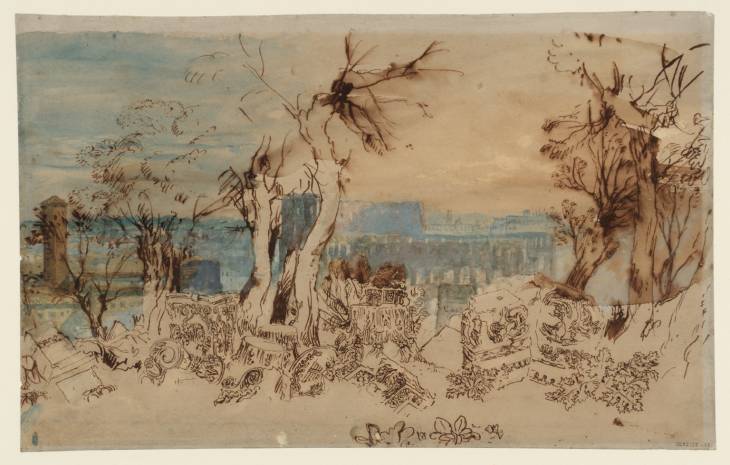Joseph Mallord William Turner View of the Colosseum from the Palatine Hill, Rome 1819
Joseph Mallord William Turner,
View of the Colosseum from the Palatine Hill, Rome
1819
Joseph Mallord William Turner 1775–1851
View of the Colosseum from the Palatine Hill, Rome 1819
D16369
Turner Bequest CLXXXIX 42
Turner Bequest CLXXXIX 42
Gouache, pen and ink, watercolour, and grey watercolour wash on white wove ‘Valleyfield’ paper, 229 x 366 mm
Stamped in black ‘CLXXXIX 42’ bottom right
Stamped in black ‘CLXXXIX 42’ bottom right
Accepted by the nation as part of the Turner Bequest 1856
Exhibition history
1904
National Gallery, London, various dates to at least 1904 (600b).
1981
Turner’s First Visit to Italy, 1819: Watercolours from the Turner Bequest, Loaned by the British Museum, Tate Gallery, London, April–October 1981 (no catalogue).
1983
J.M.W. Turner: Dibujos y acuarelas del Museo Británico, exhibition catalogue, Museo del Prado, Madrid, February–March 1983 (31, reproduced).
References
1904
E.T. Cook and Alexander Wedderburn (eds.), Library Edition: The Works of John Ruskin: Volume XIII: Turner: The Harbours of England; Catalogues and Notes, London 1904, no.600(b), pp.300, frame no.111, drawing no.232, 636, as ‘A Foreground at Rome’ and ‘Rome from the Gardens of SS. Giovanni e Paolo’.
1909
A.J. Finberg, A Complete Inventory of the Drawings of the Turner Bequest, London 1909, vol.I, p.563, as ‘Rome, from the Gardens of SS. Giovanni e Paolo. Pen and ink and watercolour. 600b, N.G.’.
1920
D[ugald] S[utherland] MacColl, National Gallery, Millbank: Catalogue: Turner Collection, London 1920, p.88.
1983
Lindsay Stainton and Andrew Wilton, J.M.W. Turner: Dibujos y acuarelas del Museo Británico, exhibition catalogue, Museo del Prado, Madrid 1983, no.31, p.52 reproduced, as ‘Roma: desde los jardines de la iglesia de San Juan y San Pablo’.
Contrary to Ruskin’s and Finberg’s belief that this sketch of the Colosseum represents a view from the gardens of Santi Giovanni e Paolo on the Caelian Hill, Turner’s location was actually the Palatine Hill near the Church of San Bonaventura. The Palatine Hill was one of the most popular vantage points in Rome and Turner made a large number of studies recording views of the city seen in all directions. This drawing represents the prospect from the north-eastern side looking towards the Colosseum and the Arch of Constantine. On the left is the bell-tower of Santa Francesca Romana, and just visible as a blue silhouette in the far distance on the far right-hand side is the Basilica of San Giovanni in Laterano. Related views from the Palatine can be found on other pages within this book (see Tate D16346, D16356, D16382, D16394; Turner Bequest CLXXXIX 20, 30, 53, 62a. For further sketches of the Colosseum see D16349; Turner Bequest CLXXXIX 23). Scattered across the foreground is an array of sculptural Roman remains which Turner has carefully delineated with pen and ink. John Ruskin described the focus of the sketch as the comparison of the Corinthian capitals with their stylised acanthus leaf decoration, to the real living plants growing amidst the ruins, adding that ‘is very characteristic of Turner to be interested in such an accident as this’.1 Indeed, Turner made a detailed study of acanthus near the Palatine Hill in the Small Roman C. Studies sketchbook (see Tate D16456; Turner Bequest CXC 42).
Like many drawings within the Rome C. Studies sketchbook, the composition has been executed over a washed grey background. Turner started with a basic outline in pencil before partially developing the scene with pen and ink and watercolour. Unfortunately, in common with many of the sketches and watercolours chosen for display during the late nineteenth and early twentieth centuries, the sheet has suffered from overexposure to light and the paper has become irreversibly faded and discoloured. Peter Bower has suggested that this is probably down to the high content of indigo in the grey watercolour wash, rather than properties within the paper.2
There is another drawing on the verso (D40050).
Nicola Moorby
July 2009
John Ruskin, ‘Catalogue of the Turner Sketches in the National Gallery’, London 1857, reproduced in E.T. Cook and Alexander Wedderburn (eds.), Library Edition: The Works of John Ruskin: Volume XIII: Turner: The Harbours of England; Catalogues and Notes, London 1904, p.300.
How to cite
Nicola Moorby, ‘View of the Colosseum from the Palatine Hill, Rome 1819 by Joseph Mallord William Turner’, catalogue entry, July 2009, in David Blayney Brown (ed.), J.M.W. Turner: Sketchbooks, Drawings and Watercolours, Tate Research Publication, December 2012, https://www

